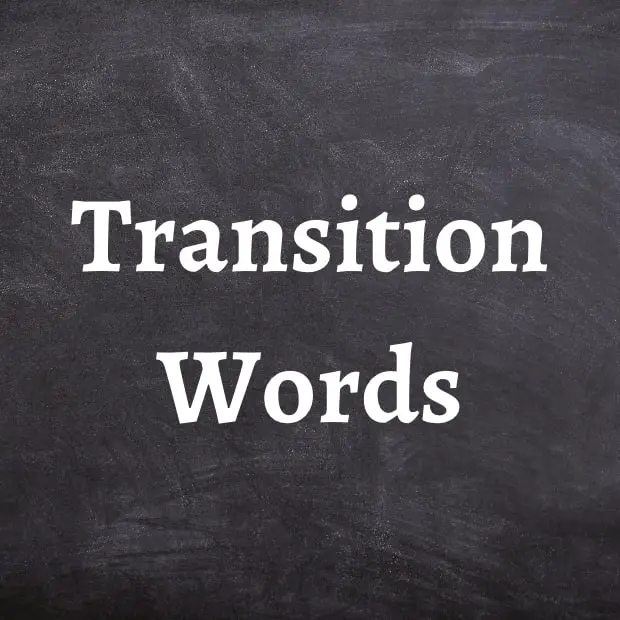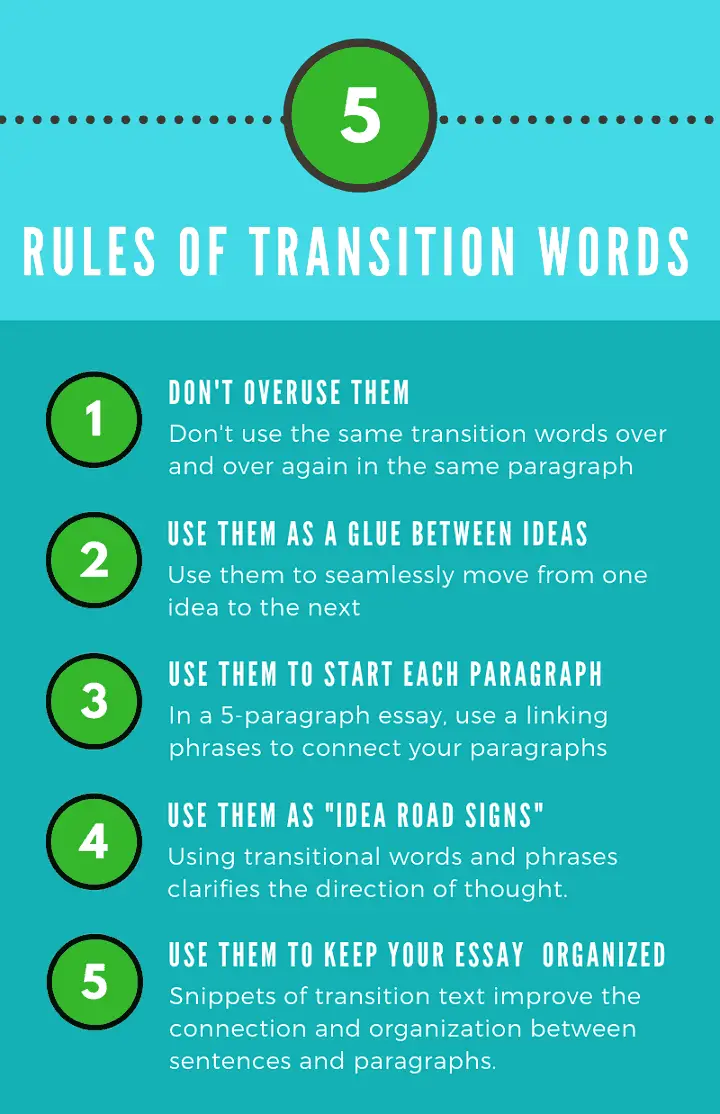
Your essay needs to be coherent and written in a way where one idea flows naturally to the other, and for that, you need transition words.
But how to make sure that everything ties together, and that you present your arguments in a logical, smooth manner? It’s simple. You do it by using transition words and phrases, which can turn your scattered thoughts into a well-organized, and neatly looking piece of prose. “Look on every exit as being an entrance somewhere else.” – Tom Stoppard It is common knowledge that the ability to write a great essay is tremendously helpful to those who are pursuing higher education. So, it wouldn’t hurt to add all the weapons you can find to your essay-writing arsenal, like these transition words.
What are transition words?
Transition words and phrases are a part of speech, and they’re used to create coherent relationships between ideas in the text. The ones you might be familiar with are ‘and’, ‘but’, ‘so’, and ‘because’. They’re applied to maintain a logical, uninterrupted stream of thought and a smooth flow of paragraphs and sentences. Their goal is to show your reader the relationship between phrases, sentences, or even paragraphs. When you use them, you make it easier for your readers to understand how your thoughts and ideas are connected. There are around 200 of them in the English language. Example: Regular exercise leads to improved cardiovascular performance. It improves the function of the brain.
Here are the main rules for the usage of transitional words:

Using transitional words in essays
Your regular essay will comprise five paragraphs – an introduction, three paragraphs to present your points, and a conclusion. Your job is to make the prose consistent, and that’s why you need words and phrases to create links between the ideas. The words and phrases below are mostly used in persuasive (argumentative) essays where you need to convince the readers of your opinion confidently. But in fact, they’re useful in almost any type of writing (such as expository essays) simply to keep the structure intact. If you use them well, they can emphasize contrast, highlight a similarity, and solidify your conclusion. Transition, a formal definition: the process of changing from one situation, form, or state to another.
Transition words are used at the beginning of each new paragraph. For Example:
- To begin with
- In the first place
- Secondly
- To summarize
They can also be used when you present a new point in the same paragraph. For Example:
- Moreover
- Of course
- Besides
- Whereas
There’s a multitude of transition words that will contribute to a sleeker essay
Many students make the mistake of repeating the same words repeatedly. This causes them to lose impact and meaning. Among grammarians, this phenomenon is called grammar saturation. The important thing to know is that there are several categories to transition words depending on the type of impact you’d like to create in your writing. Often, there are several words suitable for one transition. Just remember that they don’t always mean the same and you might need some practice to recognize the subtle differences between them. To avoid this, look up synonyms and never use the same transition word more than once in a single piece of prose (especially in the same paragraph). If you need a more in-depth course on this topic, you may read A Writer’s Guide To Transitional Words and Expressions.
Here’s a list of the best transition words that’ll come to your rescue:
When you want to indicate similarity or addition:
- Again
- Also
- And
- Incidentally
- By the way
- Further
- More important
- In the first place
- As well
- Even
- Indeed
- Truly
- Another
- Another
- As if
- Besides
- Equally
- For instance
- Furthermore
- In addition
- In fact
- In general
- In the same fashion
- Similarly
- Too
Examples of use:
- A diet based mostly on carbohydrates can cause massive weight gain. Furthermore, it can cause mental fog and a lack of energy in adult humans.
- Small steps can lead to huge gains. For instance, if you write one page a day, you’ll have a whole book within one year.
When you want to indicate dissimilarity, contrast, or contradiction:
- Although
- And yet
- As if
- By contrast
- On the other hand
- On the contrary
- Actually
- All the same
- At any rate
- At the same time
- Nonetheless
- But
- Despite this
- In reality
- However
- By comparison
- In comparison
- In place of
- Instead
- Neither
- Nevertheless
- Notwithstanding
- Otherwise
- Unless
- Yet
- While
- Unfortunately
- Still
- Despite
Examples of use:
- A ban on the possession of firearms would vastly improve the safety of the civilian population. In spite of this, the politicians won’t push it through because of the powerful gun lobby.
- Everyone knows that eating excessive amounts of sugar causes health problems. Yet, the consumption of “white poison” is higher than ever.
When you want to indicate similarity:
- Likewise
- Like
- Similarly
- In the same way
- In like manner
- Also
- Just as
- So too
- Another
Examples of use:
- Learning computer languages serves as a competitive advantage in the job market. Likewise, the ability to speak Chinese or Japanese can be beneficial.
- The cost of mobile devices around the world dropped significantly. In the same manner, laptops and TVs became more affordable.
When you want to indicate cause, effect, purpose, consequence, or result:
- As
- Accordingly
- As a result
- Therefore
- After all
- To be sure
- Knowing this
- Naturally
- Of course
- With this object
- With this end
- To this end
- With this in mind
- In many cases
- In this way
- Due to
- If
- Then
- And so too
- Because
- Consequently
- For
- Finally
- For this reason
- Fortunately
- Hence
- In any case
- In fact
- Of course
- Provided that
- Since
- So
- Then
- Therefore
- Thus
Examples of use:
- Excessive time spent at the desk at work can lead to coronary disease. Sitting for a long time is more harmful than the regular consumption of fast foods.
- Becoming a self-employed digital nomad isn’t easy. Fortunately, there are many guides and forums on this topic.
When you want to emphasize something:
- For instance
- Specifically
- In particular
- More specifically
- In other words
- In fact
- That is
- In brief
- In short
- Namely
- To illustrate
- Even
- Truly
Examples of use:
- Drinking a lot of water raises your levels of energy. In particular, filtered and purified water is the best thing to drink.
- The player dropped the ball at the very last moment. Truly, this was the reason the team was defeated.
When you want to indicate the time or sequence of events:
- Before
- Earlier
- After
- Afterward
- Later on
- Later
- Soon
- Meanwhile
- In the meantime
- Next
- Immediately
- Then
- Eventually
- At length
- In the same instant
- To begin
- In time
- In future
- Finally
- Subsequently
- Currently
- At that point
Examples of use:
- The children were starving and without water. Finally, the international convoy came to help them.
- The politician angered the crowds. Immediately, you could hear boos from every direction.
When you want to indicate spatial order or reference:
- Above
- Across
- Nearby
- Further on
- Opposite
- At that point
- On the opposite side
- On the right
- On the left
- Amid
- Adjacent
- Behind
- Below
- Beneath
- Beside
- Here
- In a corner
- In back of
- In front of
Examples of use:
- The huge mountain covered the horizon. Beneath it, there were kilometers of caverns.
- The table stood in the center of the room. On the right, you could find a few scattered pieces of furniture.
How do these words relate to the format of your essay?
If you focus on academic writing you’ll need to adhere to a specific essay format. Use the following words to create comprehensive transitions between paragraphs:
Introductory transitions
These come in handy when you craft your first supporting paragraph (the one after the introductory one). Here you usually start building on your thesis and start giving arguments in its favor.
Words to use in an introductory paragraph:
- To begin with
- In the first place
- Firstly
- The first reason
Connecting the second paragraph to the third:
- Additionally
- Another reason why
- Secondly
- Next
- Pursuing this further
- Also
Connecting the third paragraph to the fourth:
- Lastly
- Yet another reason why
- In the same way
- Pursuing this further
- One last reason why
- Also
- Thirdly
Connecting the body to the conclusion:
- In conclusion
- To sum it all up
- To summarize
- In the final analysis
- You can see why
- Finally
- To wrap it all up
- Therefore
- All in all
Pro tip: Words like ‘for’, ‘and’, ‘nor’, ‘but’, ‘or’, ‘yet’, and ‘since’ shouldn’t be used at the beginning of a sentence if you’re writing a formal essay. “The best part of your story is when it changes.” – Bella Bloom Bonus material – a printable PDF chart with link words (always keep it beside you): A complete list of transition words and conjunctions.
Now it’s your turn to use these transition words
Starting an essay is always challenging, even for advanced writers. Hopefully, by reading this article, I made your task easier by adding a valuable tool to your writer’s toolbox. Just remember to use these phrases originally, and without repetition. The last thing you want to do is to sound mechanical as if you’re writing from a template. Next up, you may want to check a list of amazing short pretty words in English.
Get your free PDF report: Download your guide to 80+ AI marketing tools and learn how to thrive as a marketer in the digital era.
Hey there, welcome to my blog! I'm a full-time entrepreneur building two companies, a digital marketer, and a content creator with 10+ years of experience. I started RafalReyzer.com to provide you with great tools and strategies you can use to become a proficient digital marketer and achieve freedom through online creativity. My site is a one-stop shop for digital marketers, and content enthusiasts who want to be independent, earn more money, and create beautiful things. Explore my journey here, and don't miss out on my AI Marketing Mastery online course.


